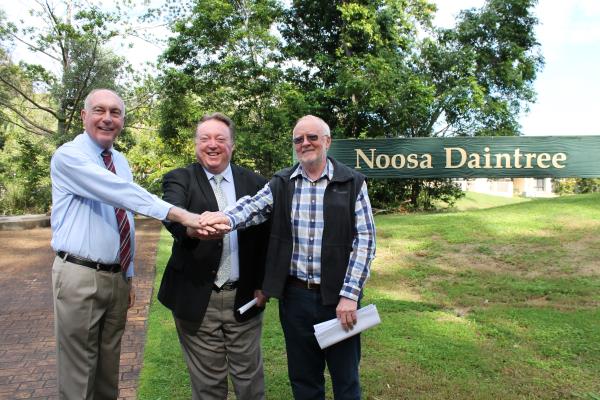
THE first stage of the flood mitigation works for Tewantin’s Daintree Estate are underway, with plans in place for looking after the local flora and fauna.
The three tiers of government united in July to announce the planned works, with over $1.2 million allocated in a bid to prevent scenes seen in the 2012 deluge where more than 40 homes were flooded.
Councillor Tony Wellington, who was instrumental is the push to flood-proof the Daintree Estate, said flora and fauna surveys had to be carried out before work could begin.
“These (the surveys) identified two species of concern. One was the vulnerable Tusked Frog and the other a near-threatened plant, the Hairy Hazelwood,” he said.
“The scientific name for this plant is Symplocos harroldii, named in honour of Dr Arthur Harrold, the founder of Noosa Parks Association.”
Cr Wellington said Noosa and District Landcare had come on board to translocate the Hairy Hazelwoods to the adjoining National Park, as well as take cuttings to generate new plants.
“In dealing with the Tusked Frog and other fauna, council has engaged a professional ecologist to be on-site,” Cr Wellington said.
“Every morning the ecologist will inspect the equipment being used to make sure there are no hidden animals. They will then keep a watch through the working day for creatures that may need to be relocated. There will also be follow-up monitoring with a particular focus on the Tusked Frog when the works are completed.“
A detailed Environmental Management Plan has been written for the flood mitigation works. According to Noosa Council’s project manager Adam Britton the document covers not only roles and responsibilities, but also management of air, noise and water quality.
“Council takes the environmental management of this project very seriously,” Mr Britton said.
“We have systems and resources in place to reduce impacts to the environment. In terms of the overall design, council will achieve the desired 1 in 100 year flood mitigation for Daintree properties.
“Clearing downstream of Golf Course Drive will occur with the least possible effect on the surrounding bush. “And instead of a wide earth mound or levee around the actual estate, the design now calls for a retaining wall that will have a much smaller footprint.”
Cr Wellington said this was good news for the residents of Daintree Estate and the best possible news for native species.
“Clearly some disturbance of habitat is necessary, but that will be kept to an absolute minimum. And when all the works are complete, the Daintree residents and the Tusked Frogs can look forward to a good drop of rain,” he said.






